Copper State Models 1/48 Lohner B.II By Jim Schubert | 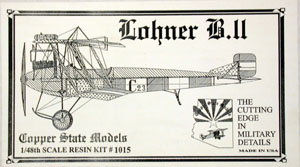 | History The Jacob Lohner Company began building one-off airplane designs for private customers in 1909. Prior to WWI they had several small "production" runs for the Austrian Army's Luftschiffabteilung (LA) (Airship Section). The most successful of these was the two-place Type "B". The LA, however, wanted a plane with better altitude capability than the "B" and asked Lohner, in 1912, to design a "Gebirgsflieger" (Mountain Flyer). The resulting Type "C" was lighter and had greater wing area than the "B". Its Hiero 85 hp four cylinder, in-line, liquid cooled engine produced five fewer horsepower than the "B"s 90 hp Daimler, but was also 112 pounds lighter. The first prototype failed its static structural test. The engineers' claimed a safetly factor of 5 for the redesign. The LA accepted the second prototype in August 1913. The first lot of 24 airplanes were in process of being built when an early production Type "C" suffered wing failure in flight. Apparently the design objective of a safety factor of five was not achieved! All "C"s were grounded and production stopped until a strengthened wing was designed and proven. Upon satisfactory completion of structural testing the already delivered planes were retrofitted with the new stronger wings and they were made standard for all new production. Satisfied that the wing structural problems were behind them the LA ordered a further 18 Type "C"s. When Austria mobilized for war, the "C"s were not yet ungrounded but by August 1, 1914 six were released for service with the remainder following quickly thereafter. The "C"s were used for artillary spotting and for observation in support of infantry patrols. Its low speed and fragility made it completely unsuited to front line use. These Lohners were, therefore, replaced with  German types as quickly as possible; the "C"s being relegated to training and communications duties. A Lohner "C" has, however, the distinction of scoring the first air-to-air victory of WWI for the Austrian forces when an observer shot down an unarmed Italian scout with a hand-held rifle in late August 1914. Whilst still in front line use some "C"s were fitted with a single light machine gun flexibly mounted on a pillar in the observer's cockpit. German types as quickly as possible; the "C"s being relegated to training and communications duties. A Lohner "C" has, however, the distinction of scoring the first air-to-air victory of WWI for the Austrian forces when an observer shot down an unarmed Italian scout with a hand-held rifle in late August 1914. Whilst still in front line use some "C"s were fitted with a single light machine gun flexibly mounted on a pillar in the observer's cockpit. In February 1915 the LA revised their type numbering system with the Type "C" becoming the Type "B.II". Also in 1915 Flugzeugwerk Fischamend designed a simpler, stronger wing that was retrofitted to all Type "B.II"s. The LA then ordered 45 further examples of this, by now, obsolete airplane from Fischamend as Lohner Type "B.II (Fd)" for use as trainers. The LA retired the last Lohner "B.II" from active service in June 1917.  The subject of the kit, C.23/12.23 is from the first production lot of 24 airplanes serialled C.1 to C.25; later reserialled B.II, 12.1 to B.II, 12.25. The kit subject has the later simpler wing with fewer, stronger, ribs. Because of the extreme sweepback of their wings these Lohners were commonly called "Pfeilfliegers" (Flying Arrows). The subject of the kit, C.23/12.23 is from the first production lot of 24 airplanes serialled C.1 to C.25; later reserialled B.II, 12.1 to B.II, 12.25. The kit subject has the later simpler wing with fewer, stronger, ribs. Because of the extreme sweepback of their wings these Lohners were commonly called "Pfeilfliegers" (Flying Arrows).
The Kit 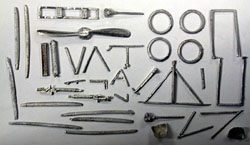 Fourteen very well mastered and cast resin parts form the core of this kit of a very unusual subject. The fuselage comes in six pieces. Each of the four mainplane panels is cast in one piece with separate ailerons for the uppers. The tailplane is cast in one piece; the fin and rudder are separate pieces. CSM also include a separate kit, of three resin parts, for the Hiero engine. The 37 white metal parts, lamentably, appear to be rather casually mastered and cast and have somewhat indeterminate and inconsistent cross sections with rather rough surfaces. A lot of clean up and correction work will be required on all of the white metal parts before they can be used. Inexplicably, two Schwarslose machine guns are included. These Lohners were never so armed and there is no mention of the Fourteen very well mastered and cast resin parts form the core of this kit of a very unusual subject. The fuselage comes in six pieces. Each of the four mainplane panels is cast in one piece with separate ailerons for the uppers. The tailplane is cast in one piece; the fin and rudder are separate pieces. CSM also include a separate kit, of three resin parts, for the Hiero engine. The 37 white metal parts, lamentably, appear to be rather casually mastered and cast and have somewhat indeterminate and inconsistent cross sections with rather rough surfaces. A lot of clean up and correction work will be required on all of the white metal parts before they can be used. Inexplicably, two Schwarslose machine guns are included. These Lohners were never so armed and there is no mention of the 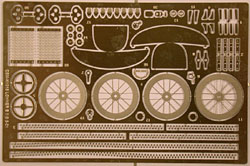 guns in the kit's sparse instructions. A dedicated photo-etch sheet is included along with a PE set of German instrument bezels and film instrument faces. Decals by Microscale include the early and late serials - C.23 and 12.23 along with "Maltese" crosses for the wings and rudder. I cannot confirm, from the references noted below, that this particular airplane ever carried crosses; but it is possible that as "12.23" it may have. I'll stick with what I can confirm and leave the crosses off. guns in the kit's sparse instructions. A dedicated photo-etch sheet is included along with a PE set of German instrument bezels and film instrument faces. Decals by Microscale include the early and late serials - C.23 and 12.23 along with "Maltese" crosses for the wings and rudder. I cannot confirm, from the references noted below, that this particular airplane ever carried crosses; but it is possible that as "12.23" it may have. I'll stick with what I can confirm and leave the crosses off.
The nine pages of instructions, despite their number, don't convey much information. There is a page of history, specs and references, a half page of terse building notes, a page for the PE parts map, a page listing the kit contents and four pages of general arrangement, 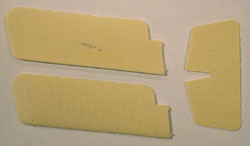 color and markings drawings. This scarcity of information and guidance led one of my IPMS-Seattle colleagues to pronounce this kit, "Unbuildable"! Actually, I think it's quite buildable and a far sight better than the CMR Seafang reviewed in the October issue and the Blue Max Snipe reviewed in the July issue. And it's also so darned intriguingly unusual - my kind of airplane - a cross between a Ronald Searle design and a Heath Robinson creation. color and markings drawings. This scarcity of information and guidance led one of my IPMS-Seattle colleagues to pronounce this kit, "Unbuildable"! Actually, I think it's quite buildable and a far sight better than the CMR Seafang reviewed in the October issue and the Blue Max Snipe reviewed in the July issue. And it's also so darned intriguingly unusual - my kind of airplane - a cross between a Ronald Searle design and a Heath Robinson creation. The kit designer appears to have been somewhat indecisive in what he was doing as he provided both cast white metal seats and PE seats, neither of which is very nice. I plan to use Fotocut's PE WWI seatbacks for a lighter appearance. CSM's photo-etched cross-lace wire wheels have only 16 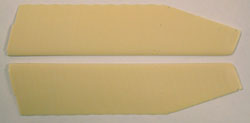 spokes per lace plane and look a bit too open compared to photos of the real plane. I plan to use Tom's Modelworks Set #205, which features cross-laced wheels with 20 spokes per lace plane. CSM provide roughly cast white metal tire and wheel rim halves with which to sandwich the PE spokes. There'll be lot of filling and filing to get these to look right. spokes per lace plane and look a bit too open compared to photos of the real plane. I plan to use Tom's Modelworks Set #205, which features cross-laced wheels with 20 spokes per lace plane. CSM provide roughly cast white metal tire and wheel rim halves with which to sandwich the PE spokes. There'll be lot of filling and filing to get these to look right. A certificate packed with the kit offers the first 100 respondents a "Limited Production Laminated Hand Carved Wooden Prop" for $12.00 plus $2.50 S & H. The hub of the plane's prop was so shaped as to form a sort of spinner that defines the shape of the nose of the airplane. The kit's white metal prop casting misses the mark completely as neither face of the hub is even slightly round, nor are they close to  being parallel. I think I'll save my $14.50 and carve my own laminated wood prop. That way I'll know it's correct. By the way, the upper and lower resin nose castings, when joined, do not form a round prop opening at the front - more "Scratchbuilding-out-of-the-box". being parallel. I think I'll save my $14.50 and carve my own laminated wood prop. That way I'll know it's correct. By the way, the upper and lower resin nose castings, when joined, do not form a round prop opening at the front - more "Scratchbuilding-out-of-the-box". Conclusion I'm looking forward to building this plane. It will have a very nice period look of light, fragile airy structure and will be quite colorful. Large areas of the wings, tail and fuselage are painted in the Austrian national colors of white and red. The upper deck and the nose of the fuselage are painted pale gray and the balance of the fabric covering is clear-doped linen. The kit is quite buildable with no more than the problems usually associated with limited run, "Cottage Industry", kits and it is distinctive enough to be worth the trouble. It is definitely not just another Messerfirestang. The retail price is $48.00. References Austro-Hungarian Army Aircraft of World War One: Peter M. Grosz, George Haddow & Peter Schiemer, Flying Machines Press, Mountain View, CA, 1993, ISBN 0-9637110-8. Air Aces of the Austro-Hungarian Empire 1914 - 1918: Dr. Martin O'Conner, Flying Machines Press, Mountain View, CA, 1986, ISBN 0-9637110-1-6. Windsock Magazine Vol. 17, No. 5 - September/October 201: In-the-box-review of this kit. The literature packed with the kit lists another reference not available to me: Reconnaissance & Bomber Aircraft of the 1914 - 1918 War: W. M. Lamberton, Harleyford Publications, Ltd. 1962. If any reader knows of other useful references, I should appreciate being so advised. | 

 



|
